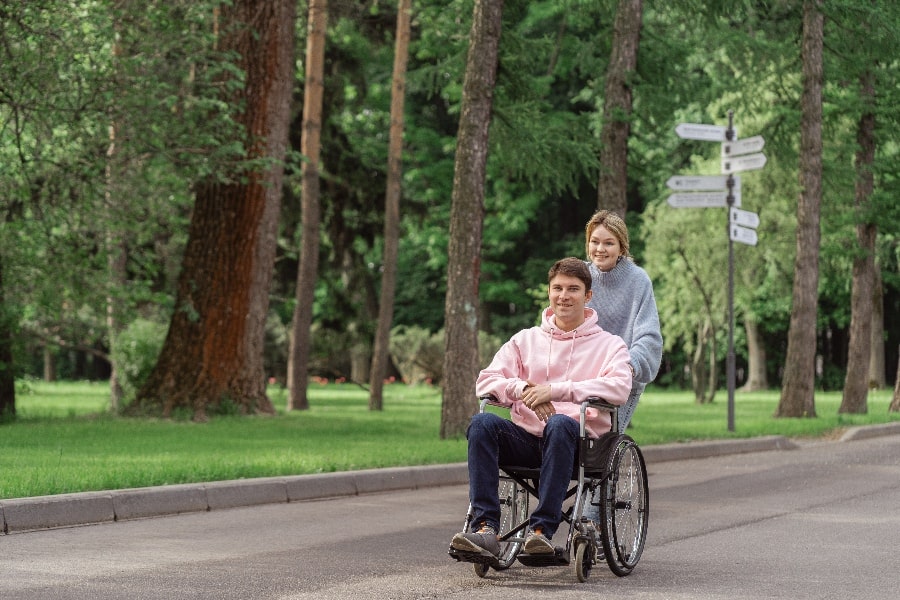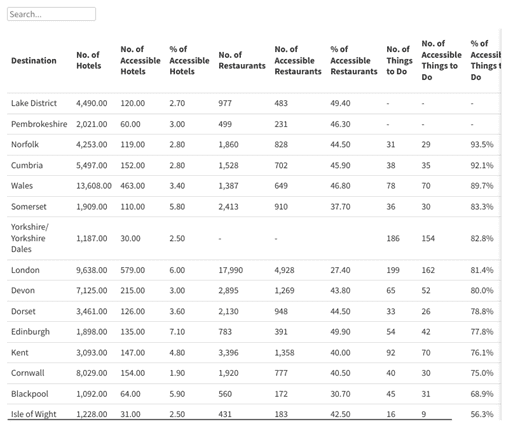Study ranks 26 locations in the UK on accessibility for staycations
A new study has revealed the best and worst places to stay for an accessible UK holiday, ranking locations on factors such as accessible hotels, dining and activities and attractions.
The findings come at the height of the summer holiday season, when more of people are likely to book a staycation. For over 14.6 million people in the UK with a disability, choosing a location that can cater to their mobility needs will be top of their list, says Senior Stairlifts.
Senior Stairlifts, an installer of stairlifts across the north of England, has broken down the main destinations to see which staycation spots are doing the most for those with accessibility needs, as well as which ones are not.
From the Scottish Highlands all the way down to London, Senior Stairlifts has pulled figures from 10 of the busiest cities and holiday destinations, ranking them based on a number of variables.
The study highlights the importance of prioritising accessibility in these spaces across the UK, especially as sources such as the Financial Times say visits to top tourist attractions continue to struggle after the pandemic.
It’s important to think about the impact of accessibility as it affects all of us.
Senior Stairlifts say, not only does accessibility make the country a more usable place for 22 percent of the population who depend on wheelchairs, but it also contributes to the local economy of some of the most beloved spots so we can enjoy these places for many years to come.
Main findings include Edinburgh, the city famed for its steep hills and The Scotsman Steps, comes top as the UK’s most accessible location; Cornwall comes bottom of the list as the least accessible staycation hotspot; Norfolk is the top place for the most accessible overall attractions and things to do at 93.5 percent; and Leicester has the highest number of Blue Badge holders, coming in at 3,888 per capita.
Kieran Harris, Founder of Senior Stairlifts, commented: “We felt it was important to shed light on the accessibility challenges faced by millions during their UK staycations and the results are eye-opening for both the travel industry and holidaymakers. Accessibility is not just a matter of convenience, but about adopting inclusivity and equality for all.
“We are proud to highlight the best accessible staycation spots, such as Edinburgh and Wales, where everyone can enjoy their time without limitations. However, our findings also emphasize the need for continuous efforts to improve accessibility across the UK’s top tourist attractions, in particular Cornwall and the Isle of Wight, to ensure holiday experiences are truly memorable for all.”
To work out the findings, the dataset considered 26 locations from England, Wales, and Scotland, splitting them into staycation locations and the top 10 cities by population.
It also looks at where accessibility factors have been included, from restaurants and hotels to visitor attractions and Blue Badge parking, to determine which location considers mobility and autonomy for all its visitors.
For the final results, percentages from each section were collated into the overall rankings. See the graphic below on what was found:
Ranked on contributing factors such as overall accessibility, including access to various things to do, places to eat, and stay, Edinburgh took the top spot.
Second is Wales, with a selection of scenic resort spots, such as Llandudno, and notable attractions, such as Newcastle Emlyn Castle.
With more people looking to explore scenic hills and country parks, Cumbria is up next, with the county of Somerset coming in as the fifth most accessible place to spend a weekend break for wheelchair users.
The overall worst location was Cornwall followed by the Isle of Wight, then Yorkshire/Yorkshire Dales, Blackpool, and the Lake District.
Edinburgh was number one for the biggest selection of accessible hotels, with 135 out of 1,898 hotels in Edinburgh meeting accessibility needs.
On the other hand, Cornwall comes bottom in terms of accessible accommodation, with just 154 out of 8,029 fit for wheelchairs.
Once again, the data shows Edinburgh leading the way for accessible dining locations, with nearly half of the restaurants out of 783 in Edinburgh suited for wheelchair owners. In stark contrast, London, with a bustling population of 8,796,628 people and 17,990 dining spots to choose from, only has 4,928 available.
When it comes to activities and things to do on a staycation, Norfolk was at the top of the rankings. With 29 out of 31 attractions being accessible, visitors can enjoy the county’s coastline, Norfolk Broads, or attractions such as zoos, railways, and cultural spots.
At the bottom of the list was the Isle of Wight, of its 16 available attractions, such as The Needles and its beautiful beaches, just nine are accessible.
The Royal Institute of British Architects (RIBA) has published guidance to ensure that inclusion and accessibility are considered at every stage of the design and construction process.



